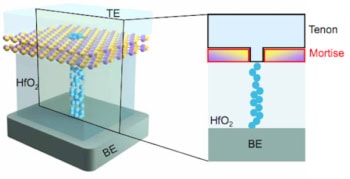
An electronic device that operates at cryogenic temperatures while controlling spin quantum bits (qubits) has been unveiled by researchers in the Netherlands. The controller could help alleviate the “wiring bottleneck” that threatens the development of quantum computers that integrate large numbers of qubits.
Researchers are developing quantum computers using several different technologies and it is not yet clear which current technology – if any – will lead to the creation of low-cost, scalable devices. Most of the competing designs pose significant challenges related to device temperature. That is because quantum computing devices typically operate at cryogenic temperatures, making them much colder than the wires and other conventional electronics used to connect the quantum devices to the outside world. This radical temperature mismatch can thwart the design and operation of quantum devices.
Now, scientists at the Delft University of Technology (TU Delft) have, in collaboration with Intel and the Netherlands Organization for Applied Scientific Research (TNO) , circumvented this issue by showing that a quantum chip can be controlled by an electronic device held at cryogenic temperatures. Writing in Nature, they report that their cryo-controller, called Horse Ridge, directed operations on a silicon-based quantum chip as successfully as more standard, off-the-shelf room temperature electronics.
“The way we build quantum chips now involves a single wire going from every qubit [quantum bit] to instrumentation at room temperature,” says Lieven Vandersypen, a physicist at TU Delft who was involved with the study. This approach, he explains, will not be practical in the future as physicists try to connect thousands or millions of qubits at a time in to perform complex computations. “At that point, the solution of having a single wire going to every qubit is no longer feasible,” he says. His team has been working on bringing electronics closer to the qubits both in terms of location and temperature in order to avoid this problem.
Connecting millions of qubits
“The problem with integrating qubits and electronics is a thermal problem, a cryostat problem really,” agrees Sorin Voinigescu, an engineer at the University of Toronto who was not involved with the study. Microwave controllers such as Horse Ridge work like a mobile phone transceiver, he notes, with the added difficulty of having to operate at low temperatures. In the future, Voinigescu says, to control millions of qubits scientists will have to pack tens of thousands of such transceivers in a tiny package within a cryostat right alongside them. The new study could be a step towards meeting this challenge.
In their experiment, the team used Horse Ridge to control a pair of spin qubits confined with a nanoscale silicon system known as a double quantum dot. The cryo-controller applied pre-programmed short bursts of microwave radiation in order to manipulate the spins or, equivalently, perform calculations with the qubits that they make up. Conventionally such microwave bursts come from room temperature electronics connected to the qubit chip through a coaxial transmission line. Horse Ridge, on the other hand, delivered them while operating at a cool 3 K temperature without sacrificing any quality.
Vandersypen, notes that in their setup, researchers could switch between directing the qubits with room temperature electronics, or with the cryogenic controller. They found essentially the same control fidelity, a promising 99.7%, in both cases. In other words, Horse Ridge’s control of the qubits was nearly 100% reliable.
Long-established technology
The cryo-controller is based on complementary metal-oxide-semiconductor (CMOS) technology, which is a long-established technology, notes TU Delft team member Edoardo Charbon. ”Putting together 60 years of experience of CMOS with qubits was a winning team,” he highlights.

Interconnected single atoms could make a ‘quantum brain’
In addition to smooth operation at temperatures of a few Kelvin, CMOS components can be relatively easily miniaturized and integrated with quantum chips, according to Charbon. Further, Horse Ridge can be programmed to execute different sets of manipulations of the qubits. “Versatility usually comes with a price in complexity and size or bulkiness of the device.” Charbon says “In our case it’s all integrated, it’s already there, all you have to do is program it differently.” Voinigescu also points out the complexity of Horse Ridge as well as its capacity to simply run more algorithms than cryo-controllers tested in past experiments.
Vandersypen hopes that the combination of versatility, high reliability and relatively straight-forward integration of CMOS technologies such as Horse Ridge can help silicon-based qubits like those in his team’s experiment move up in the quantum computer design race. At the same time, though Horse Ridge is much colder than any room temperature wire, it is still not as cold as the qubits that it controls — which are held at 20 mK. Charbon says that its temperature can be lowered a bit further, but to fully master putting the controller and the ever-growing number of qubits within the same device his collaborators will also have to engineer warmer quantum chips. “The two temperatures, one day, will be maybe the same,” he sets an ambitious goal for their future work.
The research is described in Nature.



